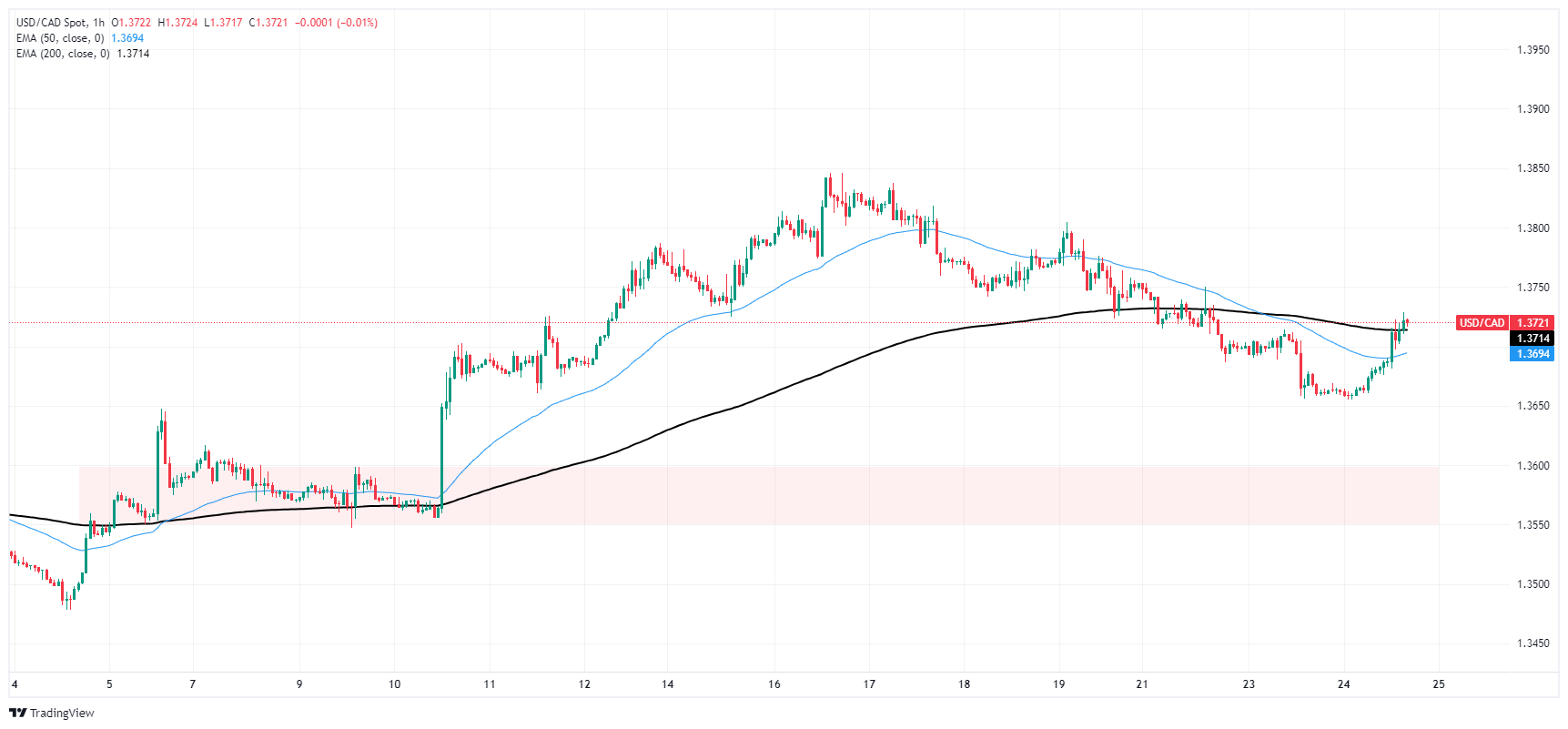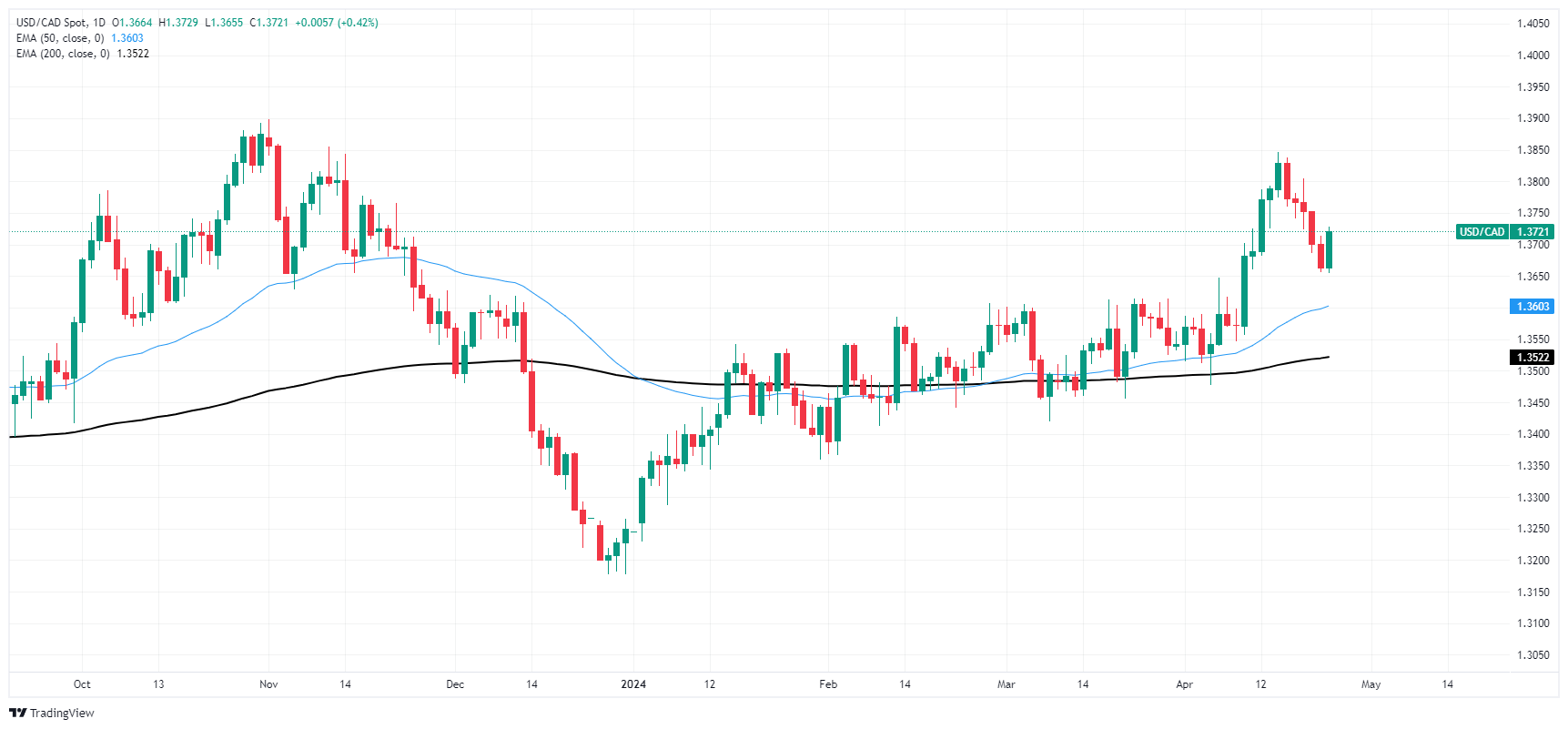Canadian Dollar gives back recent gains, Canada Retail Sales disappoint
- Canadian Dollar recedes across the board on Wednesday.
- Canada Retail Sales broadly miss the mark, hurting Loonie.
- US GDP, PCE inflation to dominate the latter half of the trading week.
The Canadian Dollar (CAD) is broadly softer on Wednesday, paring back recent gains and falling back against all of its major currency peers as the single worst-performing currency for the mid-week market session. Canadian Retail Sales flubbed forecasts, declining in February and kicking the legs out from beneath the CAD.
Canada is absent from the economic calendar for the remainder of the week, and investors will be pivoting to focus on key US data. US Gross Domestic Product (GDP) and US Personal Consumption Expenditure (PCE) Price Index inflation figures are slated for Thursday and Friday, respectively.
Daily digest market movers: Canadian Dollar pares gains as Canadian data slips
- MoM Canadian Retail Sales declined -0.1% in February, improving from the previous month’s -0.3% decline but missing the forecasted 0.1% uptick.
- Retail Sales Excluding Autos also tumbled -0.3% versus the forecast of 0.0%. January’s print was revised slightly lower to 0.4% from 0.5%.
- A broad-market recovery in the US Dollar is further pressuring CAD as investors rethink Tuesday’s broad risk appetite rally.
- Thursday’s Q1 US GDP is expected to print at 2.5% on an annualized basis, down from the previous print of 3.4%.
- Traders are hoping that Friday’s US PCE Price Index holds steady at 0.3% in March.
- Financial markets desperate for signs of rate cuts from the US Federal Reserve (Fed) have grown increasingly frustrated with ongoing signs of stubborn inflation in the US economy. Friday’s figures will drive plenty of volatility as markets grapple with rate cut forecasts.
Canadian Dollar price today
The table below shows the percentage change of Canadian Dollar (CAD) against listed major currencies today. Canadian Dollar was the strongest against the Swiss Franc.
| USD | EUR | GBP | CAD | AUD | JPY | NZD | CHF | |
| USD | 0.14% | 0.12% | 0.43% | 0.00% | 0.22% | 0.19% | 0.26% | |
| EUR | -0.15% | -0.03% | 0.29% | -0.13% | 0.07% | 0.04% | 0.09% | |
| GBP | -0.12% | 0.03% | 0.32% | -0.10% | 0.10% | 0.08% | 0.13% | |
| CAD | -0.43% | -0.28% | -0.33% | -0.42% | -0.21% | -0.24% | -0.19% | |
| AUD | 0.00% | 0.11% | 0.10% | 0.41% | 0.16% | 0.18% | 0.24% | |
| JPY | -0.23% | -0.10% | -0.10% | 0.24% | -0.21% | 0.00% | 0.02% | |
| NZD | -0.16% | -0.04% | -0.06% | 0.23% | -0.18% | 0.04% | 0.06% | |
| CHF | -0.26% | -0.10% | -0.13% | 0.19% | -0.24% | -0.03% | -0.06% |
The heat map shows percentage changes of major currencies against each other. The base currency is picked from the left column, while the quote currency is picked from the top row. For example, if you pick the Euro from the left column and move along the horizontal line to the Japanese Yen, the percentage change displayed in the box will represent EUR (base)/JPY (quote).
Technical analysis: Canadian Dollar falls across the board, USD/CAD pulls back to key technical levels
The Canadian Dollar (CAD) has weakened against all of the other major currencies on Wednesday, shedding four-tenths of a percent against the Australian Dollar (AUD) and the USD. The CAD’s least losses are against the Swiss Franc (CHF) and the Japanese Yen (JPY), falling around a fifth of a percent apiece.
The USD/CAD has risen back above the 1.3700 handle, testing chart territory north of the 200-hour Exponential Moving Average (EMA) near 1.3715. The pair bounced off the 1.3660 level to pare away Tuesday’s declines.
Wednesday’s pullback sends the USD/CAD into its first green trading day after five consecutive losing days. The pair is still down from the last swing high into 1.3850, and long-term technical support from the 200-day EMA rests near the 1.3500 handle at 1.3522.
USD/CAD hourly chart
USD/CAD daily chart
Canadian Dollar FAQs
The key factors driving the Canadian Dollar (CAD) are the level of interest rates set by the Bank of Canada (BoC), the price of Oil, Canada’s largest export, the health of its economy, inflation and the Trade Balance, which is the difference between the value of Canada’s exports versus its imports. Other factors include market sentiment – whether investors are taking on more risky assets (risk-on) or seeking safe-havens (risk-off) – with risk-on being CAD-positive. As its largest trading partner, the health of the US economy is also a key factor influencing the Canadian Dollar.
The Bank of Canada (BoC) has a significant influence on the Canadian Dollar by setting the level of interest rates that banks can lend to one another. This influences the level of interest rates for everyone. The main goal of the BoC is to maintain inflation at 1-3% by adjusting interest rates up or down. Relatively higher interest rates tend to be positive for the CAD. The Bank of Canada can also use quantitative easing and tightening to influence credit conditions, with the former CAD-negative and the latter CAD-positive.
The price of Oil is a key factor impacting the value of the Canadian Dollar. Petroleum is Canada’s biggest export, so Oil price tends to have an immediate impact on the CAD value. Generally, if Oil price rises CAD also goes up, as aggregate demand for the currency increases. The opposite is the case if the price of Oil falls. Higher Oil prices also tend to result in a greater likelihood of a positive Trade Balance, which is also supportive of the CAD.
While inflation had always traditionally been thought of as a negative factor for a currency since it lowers the value of money, the opposite has actually been the case in modern times with the relaxation of cross-border capital controls. Higher inflation tends to lead central banks to put up interest rates which attracts more capital inflows from global investors seeking a lucrative place to keep their money. This increases demand for the local currency, which in Canada’s case is the Canadian Dollar.
Macroeconomic data releases gauge the health of the economy and can have an impact on the Canadian Dollar. Indicators such as GDP, Manufacturing and Services PMIs, employment, and consumer sentiment surveys can all influence the direction of the CAD. A strong economy is good for the Canadian Dollar. Not only does it attract more foreign investment but it may encourage the Bank of Canada to put up interest rates, leading to a stronger currency. If economic data is weak, however, the CAD is likely to fall.




